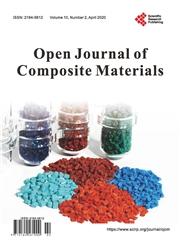Preparation of Fluoroalkyl End-Capped Oligomers/Hexagonal Boron Nitride Nanocomposites Possessing No Weight Loss Behavior in Nanocomposites Even after Calcination at 800°C
引用次数: 2
Abstract
Fluoroalkyl end-capped acrylic acid oligomer [RF-(ACA)n-RF]/hexagonal boron nitride (h-BN) nanocomposites [RF-(ACA)n-RF/h-BN] were prepared by reaction of the corresponding oligomer with h-BN nanoparticles (mean diameter: 50 nm) under non-catalytic or alkaline conditions, respectively. Fluoroalkyl end-capped N,N-dimethylacrylamide oligomer/h-BN nanocomposites [RF-(DMAA)n-RF/h-BN] were also obtained under similar conditions. It was demonstrated that RF-(ACA)n-RF/h-BN nanocomposites, which were prepared under alkaline conditions, afforded a clear weight loss in proportion to the contents of the oligomer in the composites after calcination at 800°C; however, the non-catalytic conditions enabled the RF-(ACA)n-RF/h-BN nanocomposite to give no weight loss behavior corresponding to the contents of the oligomer even after calcination. In fact, it was demonstrated that the RF-(ACA)n-RF/h-BN nanocomposites possessing a clear weight loss property could afford the fluorescent peak around 370 nm related to h-BN in the composites; however, the same fluorescent intensity of this nanocomposite after calcination at 800°C as that of the original h-BN was observed, indicating that this nanocomposite could give a clear weigh loss behavior corresponding to the content of the oligomer during the calcination process. In contrast, the RF-(ACA)n-RF/h-BN nanocomposites possessing no weigh loss behavior were found to exhibit the similar fluorescent intensity before and even after calcination at 800°C, suggesting that the corresponding nanocomposites could provide no weight loss ability corresponding to the contents of the oligomer in the composites even after calcination. Similarly, RF-(DMAA)n-RF/h-BN nanocomposites, which were prepared under non-catalytic or alkaline conditions, were found to provide no weight loss corresponding to the contents of the oligomer even after calcination, respectively. These fluorinated h-BN nanocomposites were applied to the surface modification of PMMA [poly(methyl methacrylate)] to exhibit an oleophobic property on the modified PMMA surface. RF-(ACA)n-RF/h-BN nanocomposites possessing a clear weight loss behavior, whose composites were calcinated at 800°C, afforded not oleophobic but oleophilic property on the modified PMMA surface, quite similar to that of the pristine PMMA film surface; however, more interestingly, we found that RF-(ACA)n-RF/ and RF-(DMAA)n-RF/h-BN nanocomposites possessing no weight loss characteristic, whose composites were calcined at 800°C, could supply a good oleophobic property related to the fluoroalkyl segments in the composites on the modified PMMA surfaces, respectively.氟烷基端端低聚物/六方氮化硼纳米复合材料的制备,纳米复合材料在800℃煅烧后仍无失重行为
氟烷基封端丙烯酸低聚物[RF-(ACA)n-RF]/六方氮化硼(h-BN)纳米复合材料[RF-(ACA)n-RF/h-BN]分别通过相应的低聚物与h-BN纳米颗粒(平均直径:50nm)在非催化或碱性条件下反应制备。在类似的条件下也获得了氟烷基封端的N,N-二甲基丙烯酰胺低聚物/h-BN纳米复合物[RF-(DMAA)N-RF/h-BN]。研究表明,在碱性条件下制备的RF-(ACA)n-RF/h-BN纳米复合材料在800°C下煅烧后,其重量损失与复合材料中低聚物的含量成正比;然而,非催化条件使RF-(ACA)n-RF/h-BN纳米复合材料即使在煅烧后也不会产生与低聚物含量相对应的重量损失行为。事实上,研究表明,具有明显失重性能的RF-(ACA)n-RF/h-BN纳米复合材料可以在复合材料中产生与h-BN相关的370nm附近的荧光峰;然而,在800°C下煅烧后,观察到该纳米复合材料的荧光强度与原始h-BN的荧光强度相同,这表明该纳米复合物在煅烧过程中可以给出与低聚物含量相对应的明显失重行为。相反,发现不具有失重行为的RF-(ACA)n-RF/h-BN纳米复合材料在800°C煅烧前后表现出相似的荧光强度,这表明即使在煅烧后,相应的纳米复合材料也不能提供与复合材料中低聚物含量相对应的失重能力。类似地,发现在非催化或碱性条件下制备的RF-(DMAA)n-RF/h-BN纳米复合材料,即使在煅烧后,也不会分别提供与低聚物含量相对应的重量损失。将这些氟化h-BN纳米复合材料应用于PMMA[聚甲基丙烯酸甲酯]的表面改性,以在改性的PMMA表面上表现出疏油性能。RF-(ACA)n-RF/h-BN纳米复合材料具有明显的失重行为,其复合材料在800°C下煅烧,在改性的PMMA表面上表现出不疏油但亲油的性质,与原始PMMA膜表面非常相似;然而,更有趣的是,我们发现RF-(ACA)n-RF/和RF-(DMAA)n-RF/h-BN纳米复合材料不具有失重特性,其复合材料在800°C下煅烧,可以分别在改性PMMA表面上提供与复合材料中的氟烷基链段相关的良好疏油性能。
本文章由计算机程序翻译,如有差异,请以英文原文为准。
求助全文
约1分钟内获得全文
求助全文

 求助内容:
求助内容: 应助结果提醒方式:
应助结果提醒方式:


